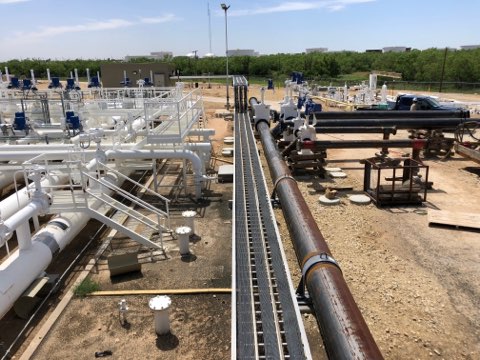Superior Rentals Contact: how to reach them
Wiki Article
Everything About Oil Field Equipment and Pipeline Equipment: Key Insights and Important Details
Oil field equipment and pipeline systems play a pivotal function in the oil and gas sector. They are important for the effective removal and transportation of hydrocarbons. Key elements, such as piercing rigs and tank, directly effect functional success. Improvements in modern technology promise to enhance safety and effectiveness. Comprehending these aspects is essential for any person associated with or interested in this complex industry, as it sets the phase for much deeper expedition of sector techniques.
Review of Oil Field Equipment
As the demand for oil continues to expand, understanding the tools used in oil areas ends up being significantly necessary. Oil field equipment encompasses a wide variety of equipment and tools vital for exploration, removal, and processing. Trick parts consist of piercing rigs, which are essential for getting to oil reservoirs, and production devices, such as separators and pumps, that facilitate the removal procedure. Superior Oilfield Rentals oilfield. Additionally, tank play a considerable function in holding unrefined oil before transportation. Safety and security equipment, including blowout preventers and stress determines, ensures functional safety and security and efficiency. Each piece of tools features cohesively to optimize production and preserve efficient operations. Familiarity with this equipment is crucial for specialists in the sector to assure successful operations and adherence to safety requirementsKinds Of Drilling Rigs and Their Applications
Drilling rigs function as the foundation of oil removal procedures, with various types developed for certain geological problems and functional demands. One of the most usual types include rotating drilling rigs, which use a rotating drill bit to penetrate the earth, and cable television tool rigs, understood for their percussion boring technique. For offshore operations, jack-up rigs and semi-submersible rigs supply security and assistance in aquatic settings. In addition, directional exploration rigs make it possible for operators to drill at angles, reaching deposits that are not up and down available. Each gear kind has unique benefits, maximizing performance and safety and security based upon the boring atmosphere. Choosing the appropriate gear is essential for optimizing source extraction while minimizing ecological influence and operational costs.
Crucial Pipeline Equipment and Their Features
Pipeline infrastructure is crucial for the transport of oil and gas from extraction websites to processing centers and end-users. Different essential tools components promote this process. Pipes themselves function as the primary channels, designed to hold up against high pressure and harsh compounds. Pump terminals are essential for preserving circulation by increasing stress along the pipeline. Valves play a crucial role in managing flow and isolating areas for maintenance. Furthermore, installations and ports assure protected joints in between pipeline sections. Checking systems, including flow meters and stress sensors, are crucial for spotting leakages and maximizing flow rates. Pigging devices is employed for maintenance and cleaning, protecting pipeline stability and efficiency. Together, these elements create the foundation of a trustworthy pipeline system.Innovations and Technologies in Oil and Gas Equipment

Safety and Maintenance Practices in the Oil Sector
While the oil market has actually made significant strides in modern technology and efficiency, the significance of durable safety and security and maintenance practices can not be overstated. Reliable safety procedures are important to safeguard workers and the setting, decreasing the risk of mishaps and spills. Routine examinations and upkeep of equipment help determine possible concerns prior to they rise, ensuring operational integrity. Training programs for workers are crucial, stressing the relevance of safety and security awareness and emergency response procedures. Additionally, adherence to industry policies and requirements promotes a society of safety and security. Applying innovative surveillance modern technologies can better boost upkeep techniques, permitting real-time analyses of devices conditions. Eventually, prioritizing safety and upkeep is indispensable to the sustainability and success of the oil sector.Regularly Asked Concerns
What Are the Environmental Impacts of Oil Field Equipment?
The environmental influences of oil field equipment include environment damage, water contamination, and air pollution (Superior Oilfield Rentals oilfield). Furthermore, tools malfunction can bring about spills, negatively affecting wild animals and ecosystems, highlighting the requirement for stringent guidelines and monitoring
Just How Is Oil Field Equipment Moved to Remote Locations?
Carrying oil field equipment to remote areas typically entails specialized lorries, helicopters, or barges. Logistics companies coordinate courses, making sure equipment check these guys out gets here safely and effectively, taking into consideration terrain and availability to minimize delays and make best use of productivity.What Regulative Requirements Govern Oil Field Equipment?
Regulatory requirements controling oil field equipment primarily include security, environmental management, and operational effectiveness standards. Agencies such as OSHA and EPA apply these regulations to guarantee risk-free methods and decrease eco-friendly impact in oil extraction operations.What Skills Are Needed to Operate Oil Area Equipment?

Exactly How Do Oil Rates Impact Equipment Need and Usage?
water line break Oil rates significantly affect devices need and usage. Greater prices normally result in raised exploration and manufacturing tasks, driving demand for equipment. On the other hand, lower rates may lead to reduced procedures and reduced demand for equipment.Report this wiki page